Dances from the Boljevac Region
Choreography: Vladimir Spasojevic
The rich dance and vocal traditions from the valley of the Crna Reka, or Black River, and the area surrounding Boljevac, are shown through these most famous Serbian dances: Bogdankino Kolo, Keser, Trgovacko Kolo, Polomka and Rumenka. This choreography emphasizes the particularity of style of this dancing region, especially through the dance Rumenka which is still to this day the most joyfully danced in this area of Boljevac and Serbia.
The rich dance and vocal traditions from the valley of the Crna Reka, or Black River, and the area surrounding Boljevac, are shown through these most famous Serbian dances: Bogdankino Kolo, Keser, Trgovacko Kolo, Polomka and Rumenka. This choreography emphasizes the particularity of style of this dancing region, especially through the dance Rumenka which is still to this day the most joyfully danced in this area of Boljevac and Serbia.
Dances from Bosilegrad
Choreography: Vladimir Spasojevic
The humorous rhymes and dialogues between young men and women in this dance illustrate both the spirit of youth as well as the layered richness of folk motifs found in this Bulgarian influenced region of eastern Serbia. Dances from the Bosilegrad area have become very popular over the last several years among all groups of quality and skill in the Serbian community. In SKUD Oplenac’s authorized version, the dances are arranged in a unique dynamic theme to offer a choreography that theatrically “speaks” through its images. The result is an aspiring and authentic approach, expressed through various creative sensibilities and an enthusiastic dancing affinity toward this area.
The humorous rhymes and dialogues between young men and women in this dance illustrate both the spirit of youth as well as the layered richness of folk motifs found in this Bulgarian influenced region of eastern Serbia. Dances from the Bosilegrad area have become very popular over the last several years among all groups of quality and skill in the Serbian community. In SKUD Oplenac’s authorized version, the dances are arranged in a unique dynamic theme to offer a choreography that theatrically “speaks” through its images. The result is an aspiring and authentic approach, expressed through various creative sensibilities and an enthusiastic dancing affinity toward this area.
Dances from Bujanovac and Southern Serbia
Choreography: Srboljub Ninkovic
Southern Serbia is very interesting in its dynamic dances and rich variety of older, oriental-influenced melodies and rhythm. It is this diversity in dances, richness in song and text as well as rhythm that has allowed the creation of choreographies on a very high artistic level.
Southern Serbia is very interesting in its dynamic dances and rich variety of older, oriental-influenced melodies and rhythm. It is this diversity in dances, richness in song and text as well as rhythm that has allowed the creation of choreographies on a very high artistic level.
Dances from Bukovica & Knin
Choreography: Vladimir Spasojevic
Wedding customs and the songs and dances that follow these traditions in the Bukovica and Knin regions of Krajina flood the stage and pour into the audience with a feeling of joy and energy toward life that the people of this area are known for. Funny texts and rhymes describe the tone of young people as they pass time with entertaining games and songs, while more serious ones speak of the traditional view of life, marriage and family. Parting from her family, the bride arrives at her new home where she begins her new life together with her husband, bringing with her all the positive traits and characteristics of her roots. Tradition is vividly and faithfully depicted in this choreography which illustrates all the joyous aspects of a wedding. The dipla in the opening section establishes the necessary atmosphere while the rest of the dance itself is performed without musical accompaniment – only with song and vocal command.
Soloists: Bojan Radulovic, Joe Kopac, Borko Brusin, Aleksandra Trivan
Wedding customs and the songs and dances that follow these traditions in the Bukovica and Knin regions of Krajina flood the stage and pour into the audience with a feeling of joy and energy toward life that the people of this area are known for. Funny texts and rhymes describe the tone of young people as they pass time with entertaining games and songs, while more serious ones speak of the traditional view of life, marriage and family. Parting from her family, the bride arrives at her new home where she begins her new life together with her husband, bringing with her all the positive traits and characteristics of her roots. Tradition is vividly and faithfully depicted in this choreography which illustrates all the joyous aspects of a wedding. The dipla in the opening section establishes the necessary atmosphere while the rest of the dance itself is performed without musical accompaniment – only with song and vocal command.
Soloists: Bojan Radulovic, Joe Kopac, Borko Brusin, Aleksandra Trivan
 Dancer’s Fantasy in Red and Black
Dancer’s Fantasy in Red and Black
Choreography: Vladimir Herzog
The stylization of movement with the wonderful musical themes is caught on a thin thread – the style and theme of the dances falls somewhere between the rhapsody and exuberant dance of a gipsy and the aggressively dynamic style of the “cardas”. Demonstrating the virtuosity of the Hungarian dances, the Cardas’s steps and movements engage his entire body while the female embodies grace and elegance, the energy and coordination between the two harmonizes the pair. This unique and unseen combination of the gipsy’s rhapsody with the distinctive ringing cymbals and clarinet of Hungarian music will stimulate and completely enchant both the eyes and ears of all viewers.
Soloists: Nick Kopac, Desanka Djonin
The stylization of movement with the wonderful musical themes is caught on a thin thread – the style and theme of the dances falls somewhere between the rhapsody and exuberant dance of a gipsy and the aggressively dynamic style of the “cardas”. Demonstrating the virtuosity of the Hungarian dances, the Cardas’s steps and movements engage his entire body while the female embodies grace and elegance, the energy and coordination between the two harmonizes the pair. This unique and unseen combination of the gipsy’s rhapsody with the distinctive ringing cymbals and clarinet of Hungarian music will stimulate and completely enchant both the eyes and ears of all viewers.
Soloists: Nick Kopac, Desanka Djonin
Silent Dances from Glamoc
Choreography: Srboljub Ninkovic
A choreography without musical accompaniment, the varying rhythms of the dance are achieved through strong and temperamental steps on the ground and the jingle of the coins that decorate the folk costumes. Traditionally, the coins on a woman’s costume represented her social status and the wealth of her family whereas men were decorated with the coins for their acts of bravery in battle while defending their home, village and country. Leading the women through challenging steps and movements throughout the dance was used to test the strength of the women and gauge their potential ability to raise and nurture a family. This is how each man “chose his own” not only for the dance, but also for the rest of the difficult life lived by the Serbians in the poor and undeveloped cliff villages of the Dinara.
Soloists: Boris Radulovic, Aleksandra Trivan
A choreography without musical accompaniment, the varying rhythms of the dance are achieved through strong and temperamental steps on the ground and the jingle of the coins that decorate the folk costumes. Traditionally, the coins on a woman’s costume represented her social status and the wealth of her family whereas men were decorated with the coins for their acts of bravery in battle while defending their home, village and country. Leading the women through challenging steps and movements throughout the dance was used to test the strength of the women and gauge their potential ability to raise and nurture a family. This is how each man “chose his own” not only for the dance, but also for the rest of the difficult life lived by the Serbians in the poor and undeveloped cliff villages of the Dinara.
Soloists: Boris Radulovic, Aleksandra Trivan
 The Gypsy Dance
The Gypsy Dance
Choreography: Dobrivoje Putnik
This dance is the most beautiful stylized miniature that has ever been created on the stage of Serbian folk dancing thus far. Incredibly demanding in its performance, the technicality, style and character of this choreography requires one of a kind dancer to give it its volume and shape. The Oplenac version is characteristically one of the best. A small gypsy community in Vojvodina gave Putnik the material needed – with the music of the great composer Stanojlo Rajicic – to create this romantic masterpiece. The choreography shows the passion of the gypsies – who love and know how to show their love, to take and give, to each other and the audience in their dancing fervour.
Soloists: Nick Kopac, Desanka Djonin.
This dance is the most beautiful stylized miniature that has ever been created on the stage of Serbian folk dancing thus far. Incredibly demanding in its performance, the technicality, style and character of this choreography requires one of a kind dancer to give it its volume and shape. The Oplenac version is characteristically one of the best. A small gypsy community in Vojvodina gave Putnik the material needed – with the music of the great composer Stanojlo Rajicic – to create this romantic masterpiece. The choreography shows the passion of the gypsies – who love and know how to show their love, to take and give, to each other and the audience in their dancing fervour.
Soloists: Nick Kopac, Desanka Djonin.
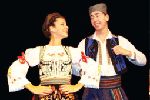 Dances from Jasenica
Dances from Jasenica
Choreography: Slavica Mihajlovic
The technique and style of dances from Central Serbia are known for their characteristic delicacy, with footwork combinations filled with complex intertwining steps, stylistic vibration of the body and strong hops and jumps. Of course differences exist within this generalization depending on the composition of the population in a specific area and the different movements and traditions they may have brought with them from other areas. The songs from this region are poetic as they most often delve into tales of love.
The technique and style of dances from Central Serbia are known for their characteristic delicacy, with footwork combinations filled with complex intertwining steps, stylistic vibration of the body and strong hops and jumps. Of course differences exist within this generalization depending on the composition of the population in a specific area and the different movements and traditions they may have brought with them from other areas. The songs from this region are poetic as they most often delve into tales of love.
“Komitsko”
Choreography: Vladimir Spasojevic
A stylized choreography created under Mira Sanjin on the occasion of the Serbian National Ensemble KOLO’s guest appearances with SCA Oplenac on their spring 2010 North American tour. The first part of the composition is significantly expanded in both number and combination of performers. The dances symbolize the historical struggle of the komita-hajduka from what are today Southern Serbia, Kosovo and Macedonia, against Turkish and Bulgarian invaders. Domination of weapons, overwhelming suffering, exalted ideals and a powerful desire for freedom are all depicted through the characteristic movements and dances of this choreography. An authentic version composed by Kresimir Baranovic, unrelated to the famous choreography created by Sanjin in 1952, which is performed in Serbia by the Ensemble KOLO, with drum variations from the repertoire of AKUD Krsmanovic, Belgrade, is planned for the 2010-2011 season.
Soloist: Nick Kopac
A stylized choreography created under Mira Sanjin on the occasion of the Serbian National Ensemble KOLO’s guest appearances with SCA Oplenac on their spring 2010 North American tour. The first part of the composition is significantly expanded in both number and combination of performers. The dances symbolize the historical struggle of the komita-hajduka from what are today Southern Serbia, Kosovo and Macedonia, against Turkish and Bulgarian invaders. Domination of weapons, overwhelming suffering, exalted ideals and a powerful desire for freedom are all depicted through the characteristic movements and dances of this choreography. An authentic version composed by Kresimir Baranovic, unrelated to the famous choreography created by Sanjin in 1952, which is performed in Serbia by the Ensemble KOLO, with drum variations from the repertoire of AKUD Krsmanovic, Belgrade, is planned for the 2010-2011 season.
Soloist: Nick Kopac
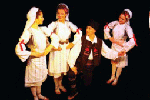 Wedding Dances from Kosovo, Gnjilane
Wedding Dances from Kosovo, Gnjilane
Choreography: Srboljub Ninkovic
Serbian dances and songs from Kosovo and Metohija are among the most beautiful throughout the entire Balkan region. The beautiful simplicity of the archaic 7/8-time melodies add pleasantness to the emotional songs and dances. The order of dances and songs presented in this choreography, in the not so ancient times, had to be strictly respected as an unwritten folk custom. The wedding begins with the dance of the mother-in-law, carrying bread for fertility, a decorated sieve for abundance, and expressing her love for the newlyweds. The wedding dance ends with the unbridled rhythm and energy of the village dance, full of large and graceful movements, plies, turns and the powerful accompaniment of the thundering drum.
Soloists: Aleksandra Trivan, Desanka Djonin, Aleksandar Todorovic
Serbian dances and songs from Kosovo and Metohija are among the most beautiful throughout the entire Balkan region. The beautiful simplicity of the archaic 7/8-time melodies add pleasantness to the emotional songs and dances. The order of dances and songs presented in this choreography, in the not so ancient times, had to be strictly respected as an unwritten folk custom. The wedding begins with the dance of the mother-in-law, carrying bread for fertility, a decorated sieve for abundance, and expressing her love for the newlyweds. The wedding dance ends with the unbridled rhythm and energy of the village dance, full of large and graceful movements, plies, turns and the powerful accompaniment of the thundering drum.
Soloists: Aleksandra Trivan, Desanka Djonin, Aleksandar Todorovic
 Songs and Dances from Montenegro
Songs and Dances from Montenegro
Choreography: Vladimir Spasojevic
This choreography demonstrates the character and pride of men from this area, their attitude and relationship to nature and their environment. These men often led a hard life in a place where nature itself could sometimes be crude and ungenerous. Therefore the nature of man makes a noble opposition to the nature around him as the men show all their openness, kindness, strength and virtue toward one another. Secret, undisclosed love is reflected in the unavoidable dances and songs which were a way to take care of life, and both familial and social norms: weddings and marriages often occurred after two people met each other in a dance and were introduced to each other’s friends and families. Strong, highlander movements, tall jumps, dominating strength of the men and gentle humility of the women are only a few of the characteristics from this region that are communicated through the songs and dance steps. Solos and individual dances within the choreography, like the toasts to the health of all those present, are unique characteristics of Montenegrian dance and are traditions that are continued at gatherings to this day.
Soloists: Aleksandar Todorovic, Natasha Trivan, Borko Brusin, Katarina Kovac, Velimir Roglic, Aleksandra Trivan
This choreography demonstrates the character and pride of men from this area, their attitude and relationship to nature and their environment. These men often led a hard life in a place where nature itself could sometimes be crude and ungenerous. Therefore the nature of man makes a noble opposition to the nature around him as the men show all their openness, kindness, strength and virtue toward one another. Secret, undisclosed love is reflected in the unavoidable dances and songs which were a way to take care of life, and both familial and social norms: weddings and marriages often occurred after two people met each other in a dance and were introduced to each other’s friends and families. Strong, highlander movements, tall jumps, dominating strength of the men and gentle humility of the women are only a few of the characteristics from this region that are communicated through the songs and dance steps. Solos and individual dances within the choreography, like the toasts to the health of all those present, are unique characteristics of Montenegrian dance and are traditions that are continued at gatherings to this day.
Soloists: Aleksandar Todorovic, Natasha Trivan, Borko Brusin, Katarina Kovac, Velimir Roglic, Aleksandra Trivan
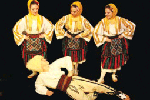 The Legend of Natama
The Legend of Natama
Choreography: Srboljub Ninkovic
The Vlaha Ungurija folk rituals and traditions from the Plavna village in the Negotin region are illustrated in this choreography. Higher powers help the residents of the village uncover who among them committed the unthinkable act of setting fire to another man’s fields. The psychological pressure of the communal rituals causes the offender to faint, revealing his guilt to those around him. These rituals served as a moral code for the community to encourage positive behaviour and regulate the relationships of the village.
The Vlaha Ungurija folk rituals and traditions from the Plavna village in the Negotin region are illustrated in this choreography. Higher powers help the residents of the village uncover who among them committed the unthinkable act of setting fire to another man’s fields. The psychological pressure of the communal rituals causes the offender to faint, revealing his guilt to those around him. These rituals served as a moral code for the community to encourage positive behaviour and regulate the relationships of the village.
Dances from Nis, “White Sunday”
Choreography: Vladimir Hercog
Pre-Christian remnants of pagan customs, beliefs and carnivals still exist in Serbia, but of course in modern forms of their performance. Today, these traditions are present mostly in the areas of Vojvodina, Pozarevac and Kosovo where these games are played at the beginning of spring during White Carnival in order to promote fertility in nature and renewal of vegetation. White Sunday preceded a period of merriment, masking and performing jokes where fires were lit in front of almost every house to help strengthen the sun and bring stronger light to nature and their crops after the winter darkness. The dirtying of faces and sharing in the name of those that have passed on symbolized a connection among community members through prayer. Dynamic games, rich and varied melodies and supporting images help to complete the cheerful atmosphere and artistic description of the carnival customs.
Pre-Christian remnants of pagan customs, beliefs and carnivals still exist in Serbia, but of course in modern forms of their performance. Today, these traditions are present mostly in the areas of Vojvodina, Pozarevac and Kosovo where these games are played at the beginning of spring during White Carnival in order to promote fertility in nature and renewal of vegetation. White Sunday preceded a period of merriment, masking and performing jokes where fires were lit in front of almost every house to help strengthen the sun and bring stronger light to nature and their crops after the winter darkness. The dirtying of faces and sharing in the name of those that have passed on symbolized a connection among community members through prayer. Dynamic games, rich and varied melodies and supporting images help to complete the cheerful atmosphere and artistic description of the carnival customs.
Dances from Macedonia
Choreography: Srboljub Ninkovic
This choreography showcases characteristic dances from Macedonia’s northern areas of Skopje and Povardrja, with only the most beautiful and best-known motifs from these regions having been selected. Temperamental dances and beautiful music, plies, turns, enthusiasm and virtuosity in the dance and especially the male ensemble, provide the eyes and ears of the viewer with an unforgetdiv experience.
Soloists: Dusan Varaklic, Mihajlo Todorovic
This choreography showcases characteristic dances from Macedonia’s northern areas of Skopje and Povardrja, with only the most beautiful and best-known motifs from these regions having been selected. Temperamental dances and beautiful music, plies, turns, enthusiasm and virtuosity in the dance and especially the male ensemble, provide the eyes and ears of the viewer with an unforgetdiv experience.
Soloists: Dusan Varaklic, Mihajlo Todorovic
The Serbian Dance
Choreography: Srboljub Ninkovic
The words and music of ‘The Serbian Dance’ illustrate the unity and brotherhood of all Serbian people. The dances meld into a harmonious composition, enhanced from the colourful costumes from many different parts of Serbia.
The words and music of ‘The Serbian Dance’ illustrate the unity and brotherhood of all Serbian people. The dances meld into a harmonious composition, enhanced from the colourful costumes from many different parts of Serbia.
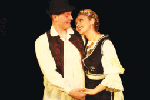 Dances from Srem
Dances from Srem
Choreography: Vladimir Spasojevic
Playful, cheerful and full of energy, Srem is truly a wonderful place, and this choreography incorporates the best known and most beautiful songs and dances from the region. Right from the start, viewers can’t help but become enchanted with the lively music and tales of young love that fill both the people and dances from Srem. The dancers of Oplenac truly show their skill through their adaptation and performance of the wide spectrum of styles and techniques found in the dances alone. The cheerful and flirtatious dialogues between the young men and women fill the stage as they sing of wine and love.
Soloists: Aleksandar Todorovic, Aleksandra Trivan
Playful, cheerful and full of energy, Srem is truly a wonderful place, and this choreography incorporates the best known and most beautiful songs and dances from the region. Right from the start, viewers can’t help but become enchanted with the lively music and tales of young love that fill both the people and dances from Srem. The dancers of Oplenac truly show their skill through their adaptation and performance of the wide spectrum of styles and techniques found in the dances alone. The cheerful and flirtatious dialogues between the young men and women fill the stage as they sing of wine and love.
Soloists: Aleksandar Todorovic, Aleksandra Trivan
The Tambura of Love
Choreography: Srboljub Ninkovic
The competition between groups of young shepherd men intertwined with the sweet tale of young love on the Old Mountain. Uncle Dobra was the best known and most prolific choreographer of his time in the territory of former Yugoslavia.
The competition between groups of young shepherd men intertwined with the sweet tale of young love on the Old Mountain. Uncle Dobra was the best known and most prolific choreographer of his time in the territory of former Yugoslavia.
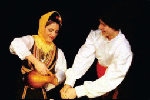 Trojanka Has Gone for Water
Trojanka Has Gone for Water
Choreography: Vladimir Spasojevic
This composition of dances from the mainly Bulgarian people of the Sopska areas are made up of small, technically very complex steps that show off not only the inevidiv competition between the boys and the girls, but their great talent as dancers as well. The composition and arrangement of musical themes to the taste of Milan Golubovic gives as much enthusiasm and joy to the listening and interpretation of the music as it does to the dance itself. Though it has clearly chosen a more stage appropriate stylization, in both music and dance, the composition of the dance still bears all the characteristics of the area. Trojanka is one of the newer choreographies that is most often – and most eagerly – performed on the current amateur dance scene in Serbia, and also compliments the stylish, artistic programs among several professional companies. In there competition with the boys, the girls do not fall behind one bit in their performance of very complex and heavy elements. A variety of rhythms and music-dancer themes lends to the evolution of a new choreography where the middle part is entirely dominated by a dance called Sopska, a new and unique dance performed only by the Oplenac dance ensemble.
Soloists: Zoran Jovicic, Teodora Ristic
This composition of dances from the mainly Bulgarian people of the Sopska areas are made up of small, technically very complex steps that show off not only the inevidiv competition between the boys and the girls, but their great talent as dancers as well. The composition and arrangement of musical themes to the taste of Milan Golubovic gives as much enthusiasm and joy to the listening and interpretation of the music as it does to the dance itself. Though it has clearly chosen a more stage appropriate stylization, in both music and dance, the composition of the dance still bears all the characteristics of the area. Trojanka is one of the newer choreographies that is most often – and most eagerly – performed on the current amateur dance scene in Serbia, and also compliments the stylish, artistic programs among several professional companies. In there competition with the boys, the girls do not fall behind one bit in their performance of very complex and heavy elements. A variety of rhythms and music-dancer themes lends to the evolution of a new choreography where the middle part is entirely dominated by a dance called Sopska, a new and unique dance performed only by the Oplenac dance ensemble.
Soloists: Zoran Jovicic, Teodora Ristic
Shopske Dances
Choreography: Dragomir Vukovic
This cult choreography is one of the best Serbian choreographies of all time and is now part of the repertoire of the temple of world folklore: the ensemble Mojseev of Mosow, Russia. The dances of this composition come from the Bulgarian population of the Sopska area and are very small, technically complex steps. The choreography illustrates the inevidiv contests between the boys and girls while highlighting their exceptional dance skills. The musical composition – the work of the great Maestro Petar Josimovic – captures the spirit and physiognomy of the Serbian National Ensemble KOLO, Belgrade, and gives as much joy and enthusiasm to both the viewer and listener.
This cult choreography is one of the best Serbian choreographies of all time and is now part of the repertoire of the temple of world folklore: the ensemble Mojseev of Mosow, Russia. The dances of this composition come from the Bulgarian population of the Sopska area and are very small, technically complex steps. The choreography illustrates the inevidiv contests between the boys and girls while highlighting their exceptional dance skills. The musical composition – the work of the great Maestro Petar Josimovic – captures the spirit and physiognomy of the Serbian National Ensemble KOLO, Belgrade, and gives as much joy and enthusiasm to both the viewer and listener.
Dances from Sumadija
Choreography: Vladimir Spasojevic
This authentic choreographic composition presents a medley of the most beautiful songs and dances from central Serbia while painting a portrait of the people of Sumadija and their attitude toward life. Even with their distinctly calm nature, there is an incredibly lyrical quality in their relationships and interactions, especially those of the young men and women when they meet at town gatherings or in churchyards. A modern choreography interwoven with the finest aspects of the Serbian tradition, the harmony of the music and songs together with the beauty of dance and movement, will enchant even the most unfamiliar viewer.
Soloists: Dino Lakic, Dejana Mileusnic
This authentic choreographic composition presents a medley of the most beautiful songs and dances from central Serbia while painting a portrait of the people of Sumadija and their attitude toward life. Even with their distinctly calm nature, there is an incredibly lyrical quality in their relationships and interactions, especially those of the young men and women when they meet at town gatherings or in churchyards. A modern choreography interwoven with the finest aspects of the Serbian tradition, the harmony of the music and songs together with the beauty of dance and movement, will enchant even the most unfamiliar viewer.
Soloists: Dino Lakic, Dejana Mileusnic
 Dances from Vladicin Han, “Beside the Ruska”
Dances from Vladicin Han, “Beside the Ruska”
Choreography: Vladimir Spasojevic
With dances from the area of Vladicin Han, this choreography includes entertaining solo miniatures and songs that depict interactions between young men and women. With the temperament and buoyant energy of the south in combination with the diverse styles and complex compositions of the dances, the choreography puts a bright light on all of the potential and prospects within the Oplenac folklore groups.
Soloists: Dino Lakic, Tanja Stanisic
With dances from the area of Vladicin Han, this choreography includes entertaining solo miniatures and songs that depict interactions between young men and women. With the temperament and buoyant energy of the south in combination with the diverse styles and complex compositions of the dances, the choreography puts a bright light on all of the potential and prospects within the Oplenac folklore groups.
Soloists: Dino Lakic, Tanja Stanisic
“And now we dance!” Vlaske Dances
Choreography: Vladimir Spasojevic in dedication to the late Professor Dragoslav Antonijevic (1930-2001) of the Serbian Academy of Arts and Sciences
Batrna, ropata and ungurjana dances, in combination with two and three-part rhythm, distinguish vlaske dances from all others in the Serbian folk dance legacy. The syncopated stomping symbolically represents the destruction of evil for its counterparts hope and light. On the other hand, the dancing-rhythmic contact of the female and male bodies in some vlaske dances presents the metaphorical connection between female fertility and fertility of the land, and male fertilization and fertilization in general. Ritual brought to reality on the best aesthetic platform, expressed not only through metaphor, but also through the dances of real love.
Soloists: Milan Marinkovic, Olivera Ivanisevic
Batrna, ropata and ungurjana dances, in combination with two and three-part rhythm, distinguish vlaske dances from all others in the Serbian folk dance legacy. The syncopated stomping symbolically represents the destruction of evil for its counterparts hope and light. On the other hand, the dancing-rhythmic contact of the female and male bodies in some vlaske dances presents the metaphorical connection between female fertility and fertility of the land, and male fertilization and fertilization in general. Ritual brought to reality on the best aesthetic platform, expressed not only through metaphor, but also through the dances of real love.
Soloists: Milan Marinkovic, Olivera Ivanisevic
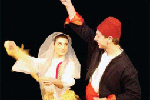 Suite of Dances from Vranje
Suite of Dances from Vranje
Choreographer: Branko Markovic
The greatest creation from Maestro Branko Markovic, this choreography is artistically unique in its on-stage execution of Balkan character dances. The choreography is comprised of three parts:
1) “Vranjanka” – the women’s dance
2) “Tesko Oro” – a difficult men’s dance
3) “Cocek” – The dance of the gypsies
Through its dance and music, this choreography illustrates five centuries worth of oriental influence on the Balkan regions. The masterful writings of Bora Stankovic describe the town of Vranje as being full of “cepenak” stores and Turkish style “avlija” courtyards – names which these people have kept in their dialect to this day. The first two parts of the choreography show the dances of the wealthier, urban population. The brethren of the famous gypsy Kostana enter in the final, incredible third part of the dance where through playful song, dance and the wildly energetic music, the dance peaks at an incredible level of energy and excitement which the dancers transfer to the audience without reserve.
Soloists: Aleksandar Todorovic, Tanja Vrbica, Velimir Roglic
The greatest creation from Maestro Branko Markovic, this choreography is artistically unique in its on-stage execution of Balkan character dances. The choreography is comprised of three parts:
1) “Vranjanka” – the women’s dance
2) “Tesko Oro” – a difficult men’s dance
3) “Cocek” – The dance of the gypsies
Through its dance and music, this choreography illustrates five centuries worth of oriental influence on the Balkan regions. The masterful writings of Bora Stankovic describe the town of Vranje as being full of “cepenak” stores and Turkish style “avlija” courtyards – names which these people have kept in their dialect to this day. The first two parts of the choreography show the dances of the wealthier, urban population. The brethren of the famous gypsy Kostana enter in the final, incredible third part of the dance where through playful song, dance and the wildly energetic music, the dance peaks at an incredible level of energy and excitement which the dancers transfer to the audience without reserve.
Soloists: Aleksandar Todorovic, Tanja Vrbica, Velimir Roglic